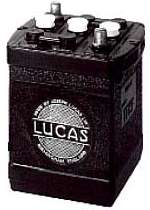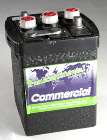The MGA With An Attitude
6-VOLT BATTERY (batteries), Original Style - ET-128
 Original style 6-volt batteries sort of suck, to put it mildly. At least half again the cost of a 12-volt battery, and you need two. They are also mostly old technology type with only moderate cranking power, and have a life expectancy of about 4 years. A single 12V will be about 1/3 the price of two 6's, have way more cold cranking power, will probably last about 6 years, and can be bought with a 72 month prorated warranty (maybe), possibly for about $49.99 (discount department store).
Original style 6-volt batteries sort of suck, to put it mildly. At least half again the cost of a 12-volt battery, and you need two. They are also mostly old technology type with only moderate cranking power, and have a life expectancy of about 4 years. A single 12V will be about 1/3 the price of two 6's, have way more cold cranking power, will probably last about 6 years, and can be bought with a 72 month prorated warranty (maybe), possibly for about $49.99 (discount department store).
The smallest commonly available 12-volt battery will not fit in the stock 6-volt battery carrier (see more recent possibilities below). In that case you need to extend one battery carrier (usually the right side) about 1-1/2 inches at the back edge (a little cut and weld). Starting should always be easier with a modern single 12 volt battery. Find information on converting the car to a single 12-volt battery in article ET-203.
Find battery size numbers here: www.jegs.com/Sizecharts/bcigroup.html

The smallest standard format 6-volt battery listed there is group 17HF (6V near bottom of list). This one is 6-7/8" wide (sometimes 6-3/4") x 7-3/8" long and 9" tall. It is smaller at the bottom, not more than 6-1/2" the narrow way. It is a direct replacement for the original battery in the MGA. The carrier is barely 6-3/4 wide (maybe 1/16" more) x 7" long (front to back), and that includes space for 1/4" thick L-shape rubber pads at both ends. So the original battery was also about 6-1/2 wide at the bottom. The original Lucas battery number was SG9E (wet as installed), or STGZ9E (dry charged for export).
The original batteries were about 300 CCA (Cold Cranking Amps). Modern replacement 6-volt batteries are usually 360 CCA (not much better than days of old). The reason the cold cranking amps is so low is because they are replacements for deep discharge batteries commonly used in golf carts or for trolling motors. Think of these as "old technology" batteries. Modern automotive batteries have much higher cold cranking amps capability, but should be kept close to full charge at all times. The high cranking capacity batteries do not tolerate deep discharge very well.
About 1 amp per cubic inch of engine displacement is enough in mild weather, so start with 100 amps minimum. But you can de-rate the battery to about 40% of the base current capacity at 0dF, and figure it will take at least 200 amps to crank the engine at that temperature, so that's not much of an excess. At -20dF you can derate the battery to about 25% of what it will do when warm, and triple the power required to crank the engine, and all bets are off for getting it started. When I was driving my MGA in the winter while in college, with two new 6 volt batteries it would (usually) start okay down to about 0dF. At -10dF it seemed to crank at a reasonable speed, but didn't seem to vaporize the fuel very well, so a sniff of ether was sometimes in order.
Another battery issue is storage capacity compared to total vehicle power consumption and generator output. Generators originally used in the MGA are Lucas C39 and C40, which have output of 19 amps or 22 amps. If you install modern 60-watt halogen sealed beam headlamps, then switch on all standard electrical equipment in the car, you may find that total power consumption is a few amps more than generator output capacity. Original batteries (2x6V together) had 58 amp-hour capacity (20 hour rate). If the vehicle is drawing 3 or 4 amps more than the generator can supply, then several hours of night driving can discharge the battery enough so it may not crank start the engine. This is why the MGA has two batteries, so the storage capacity can get the car through a long dark night of inclement weather. If you convert it to a single 12 volt battery this issue becomes a greater problem, because one 12V battery has less storage capacity than two 6 volt batteries. Also modern high current batteries don't tolerate being discharged to low levels.
|